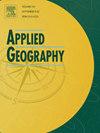基于可解释的XGBoost模型探讨中国县域人口收缩对碳排放强度的非线性影响
IF 5.4
2区 地球科学
Q1 GEOGRAPHY
引用次数: 0
摘要
了解人口萎缩对碳排放强度的影响,有助于区域可持续发展和碳减排。本研究利用可解释的极端梯度提升(XGBoost)模型研究了中国1218个县的这种影响,并分别分析了中国东部、中部、西部和东北地区的区域异质性。结果表明:①人口萎缩和碳排放强度较高的县域集中在华北和东北地区,而南方县域对人口萎缩和碳排放强度的影响较小;②在全球范围内,人口收缩与碳排放强度的非线性关系呈“v”型,从0到约- 0.007,随着收缩的加剧,碳排放强度下降,当收缩超过- 0.016时,碳排放强度再次上升。局部而言,这种非线性关系的性质在不同地区有所不同;③人口萎缩与人均GDP政府支出、土地交易面积、归一化植被指数、每万人专利数等关键变量非线性交互影响碳排放强度,且存在明显的阈值效应。例如,在轻度收缩(- 0.005-0)期间,碳排放强度在人均GDP的中等政府支出水平(0.10-0.15)时达到峰值,但这种相互作用随着收缩的加剧而减弱。值得注意的是,这些相互作用模式在不同地区的强度和方向上都有很大差异。研究结果确定了明确的阈值,帮助决策者根据不同人口缩减水平的县的具体社会经济背景设计有针对性的干预措施。本文章由计算机程序翻译,如有差异,请以英文原文为准。
Exploring the nonlinear effect of population shrinkage on carbon emission intensity in Chinese counties using an interpretable XGBoost model
Understanding how population shrinkage affects carbon emission intensity aids sustainable regional development and carbon reduction. This study investigates this influence across 1218 Chinese counties using an interpretable Extreme Gradient Boosting (XGBoost) model, with a focus on regional heterogeneity by analyzing Eastern, Central, Western, and Northeastern China separately. The main findings are: 1) Counties with more significant population shrinkage and higher carbon emission intensity are concentrated in northern and northeastern China, whereas southern counties tend to be less affected on both fronts; 2) Globally, the nonlinear relationship between population shrinkage and carbon emission intensity follows a “V-shaped” pattern, with carbon emission intensity decreasing as shrinkage intensifies from 0 to approximately −0.007, and then rising again when shrinkage exceeds −0.016. Locally, the nature of this nonlinear relationship varies across regions; 3) Population shrinkage interacts nonlinearly with key variables such as government expenditure per capita GDP, land transaction area, Normalized Difference Vegetation Index, and number of patents per 10000 people to influence carbon emission intensity, with distinct threshold effects observed. For example, carbon emission intensity peaks at moderate levels of government expenditure per capita GDP (0.10–0.15) during mild shrinkage (−0.005–0), but this interaction weakens as shrinkage intensifies. Notably, these interaction patterns vary considerably across regions in both strength and direction. The results identify clear thresholds, helping policymakers design targeted interventions based on the specific socioeconomic contexts of counties with different levels of population shrinkage.
求助全文
通过发布文献求助,成功后即可免费获取论文全文。
去求助
来源期刊

Applied Geography
GEOGRAPHY-
CiteScore
8.00
自引率
2.00%
发文量
134
期刊介绍:
Applied Geography is a journal devoted to the publication of research which utilizes geographic approaches (human, physical, nature-society and GIScience) to resolve human problems that have a spatial dimension. These problems may be related to the assessment, management and allocation of the world physical and/or human resources. The underlying rationale of the journal is that only through a clear understanding of the relevant societal, physical, and coupled natural-humans systems can we resolve such problems. Papers are invited on any theme involving the application of geographical theory and methodology in the resolution of human problems.
 求助内容:
求助内容: 应助结果提醒方式:
应助结果提醒方式:


